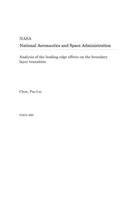
Analysis of the Leading Edge Effects on the Boundary Layer Transition
Series:
A general theory of boundary layer control by surface heating is presented. Some analytical results for a simplified model, i.e., the optimal control of temperature fluctuations in a shear flow are described. The results may provide a clue to the effectiveness of the active feedback control of a boundary layer flow by wall heating. In a practical situation, the feedback control may not be feasible
NaN
VOLUME
English
Paperback

A general theory of boundary layer control by surface heating is presented. Some analytical results for a simplified model, i.e., the optimal control of temperature fluctuations in a shear flow are described. The results may provide a clue to the effectiveness of the active feedback control of a boundary layer flow by wall heating. In a practical situation, the feedback control may not be feasible from the instrumentational point of view. In this case the vibrational control introduced in systems science can provide a useful alternative. This principle is briefly explained and applied to the control of an unstable wavepacket in a parallel shear flow. Chow, Pao-Liu Unspecified Center NAG1-460...
Price Comparison [India]
In This Series
Bestseller Manga
Trending NEWS




















